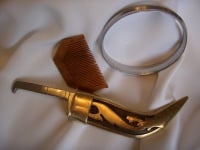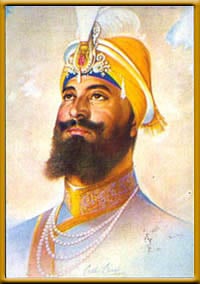Five ks: Difference between revisions
| Line 20: | Line 20: | ||
==[[Human Hair|Kesh, the LOGO of ''Sachy Gur''(True IDEAs)]]== | ==[[Human Hair|Kesh, the LOGO of ''Sachy Gur''(True IDEAs)]]== | ||
[[Image: | [[Image:Guru Gobind Singh 1.jpg|thumb|200px|left|]] | ||
Most Sikh never cuts or trims any hair (Kesh), to indicate the perfection of God's creation. A comb keeps the hair tidy, a symbol of not just accepting what God has given, but also an injunction to maintain it with grace. | Most Sikh never cuts or trims any hair (Kesh), to indicate the perfection of God's creation. A comb keeps the hair tidy, a symbol of not just accepting what God has given, but also an injunction to maintain it with grace. | ||
Revision as of 02:12, 16 October 2006
| Part of a series on Sikh Practices |
| Sikhism |
| Sanskar |
| Sikh rites |
| Personal 5 Banis . Five ks |
Sikhs wear an external uniform to unify and bind them to the beliefs of the religion and to remind them of their commitment to the Sikh Gurus at all times. Unlike some other faiths where only the clergy are in uniform, all Sikhs are enjoined to wear the uniform of their beliefs. These five articles of faith distinguish a Sikh and are essential for preserving the life of the community.
The Five Ks, or panj kakaar/kakke, are five items of faith that initiated Khalsa Sikhs wear at all times at the command of the tenth Sikh Guru, Guru Gobind Singh who so ordered at the Baisakhi Amrit Sanchar in 1699. The Five Ks are not merely symbols but articles of faith which collectively form the external visible symbols to identify and clearly and outwardly advertise and display ones commitment and dedication to the order (Hukam) of the tenth master. Guru Gobind Singh ordered his followers to wear the Five Ks so that they could actively use them to make a difference to their own and to others' spirituality.
The Five K's
Kesh (Natural 'TRUTH god' given Hair)
Kanga(wooden comb) for Maintenance & upkeep of Kesh.
Kara (steel bracelet) Symbolises unbreakable bond with 'TRUTH god' & SGGS.
Kachhera (cotton underwear) Standard, Naturally Comfortable, degnified attire reflective of modesty.
Kirpan (sword) Life line of TRUTH god's Soldier, KHALSA.
Kesh, the LOGO of Sachy Gur(True IDEAs)
Most Sikh never cuts or trims any hair (Kesh), to indicate the perfection of God's creation. A comb keeps the hair tidy, a symbol of not just accepting what God has given, but also an injunction to maintain it with grace.
The Keski/Dastaar,worn to protect the Kesh (unshorn hair), is a socilly institutional crown of humble dignity & roality, a constant reminder to the Sikh that he or she is sitting on the TRUTH god's throne of truthful consciousness and is committed to living to GurMat principles(TRUE IDEAs) defined and amplified in SGGS(Sacy Gur Granth Sahib)
- It is the social identity of a Sikh.
Sayth 10th Nanak
- “KHALSA mero roop hai kaas.
- KHALSY mai hau karon nivaas...”
- "KHALSA(TRUTH god's Sagun Swaroop) is my special persona.
- Within each KHALSA...
- ...lived even before eternity,
- ...has lived till now,
- ...is living now at this instant and
- ...will ever live beyond eternity,
- ...my special persona (TRUTH god's Nirgun Swaroop)"
- Wearing a turban(TRUTH god's own Crown) declares sovereignty, dedication, self-respect, courage and piety.
- 5Ks outline the special special persona of TRUTH god's Sagun Swaroop.
Kanga
The Kanga is kept in the hair knot and is used to keep hygiene and look after the Kesh (unshorn hair). Combing the hair twice a day, dead hair is removed and one keeps tidy.
- Main article: Kanga
Kara
Kara(Guru ki Hathkadi), Guru's personal gift to Sikhs, is an iron bracelet worn on the wrist and reflects a link between 'KHALSA' & 'TRUTH god'. It is a holy social icon epitomizing & signifying:-
- A truthful life dedicated to no one but 'TRUTH god'
- Unbreakable bond with SatGur ( Sacy Gur Granth Sahib )
- Unbreakable bond among themselves.
- Inner moral strength of the wearer to resist worldly anti social temptations.
- Regulator of Sikh's mind, when pitted against falsehood.
- Main article: Kara
Kacchera
A Kacchera is a pair of knee length shorts. Practically it covers our body and ensures a Sikh is always ready and dressed modestly. Thus it is quite useful in hot weather, swimming and sports activities. The Kachhera reminds the Sikh to uphold high moral character and to control his or her desires.
- Main article: Kaccha
Kirpan
The Kirpan represents ‘Truth & Justice’. The Kirpan reminds a Sikh of his or her duty to stand up for justice, to protect the weak and not to falter in his or her duty. The Kirpan is a Shastar, (close-combat) protective weapon, to be used in the last resort to defend oneself, to defend Faith, and to protect the weak.
Kirpan comes from the word 'KIRPA' and 'AAN'. Kirpa means an act of kindness or a favour; 'aan' means honour, respect, and self-respect. It is an instrument which adds to self-respect and self-defence. Thus for Sikhs, Kirpan is the symbol of power and freedom of spirit. All initiated Sikhs should wear a short form of Kirpan (approx. 6" to 9" long) on their body. To call it a dagger or knife is rather insulting to this article of faith, which functions quite differently from the other two. The blade should be made of iron.
A Sikh should never use the Kirpan in anger or for a malicious attack. However, a Sikh may use it in self-defence or to protect a person in need. Some Sikhs choose to learn the art of Gatka. This is a martial art devised by the Sikh Gurus that uses circular movements to effectively swing a sword.
- Main article: Kirpan
The Spiritual Signifance of the 5K's
Desires/ Lust (Kaam)
Wearing the Kachherĝ, a Sikh is reminded to control his desire and only look at his own wife or husband. The Kachherĝ reminds us to self-control and to control the urges of Kaam.
Greed (Lobh)
Wearing the Karĝ in our hand we are reminded not to commit crime or theft with our hands. The Karĝ constantly reminds us of Guru Ji and the hands which can be used to misdeeds fuelled by greed are reminded "you are bound to the Guru, remember Vaheguru is always watching you". Therefore, the Kara is a continual reminder of “Think of the Guru, before yourself”.
Anger (Krodh)
Wearing the Kirpaan, you have the power to kill someone and therefore you to have control your anger more than the other person. The Kirpan represents the Grace, Truth and Justice, which a Sikh represents which can only happen if a Sikh has no anger.
Attachment (Moh)
Combing the hair twice a day, when one sees the dead hair being combed out, one is reminded that just as our hair are not permanent, so is everything around us. One should comb one's mind with Gurbaani (the Divine Word), just as one comb's their hair with a comb.
Ego (Haumai)
Maintaining Kesh covered with a Dastaar (turban) on the head one commits him or herself to higher consciousness, saving them from vanity. Crowning oneself with a Dastaar one is reminded that their head belongs to Guru Sahib and that they should not have ego. With a turban covering the hair-knot on top of Dasam Duaar (a spiritual opening on the top of the head), all worldly fashion stops dead. The Dastaar guards the Sikh man and woman from drowning in vanity and society-led fashions. A man or woman wearing a turban well be self-conscious of living up to their principles, living up to the image they are portraying and the Guru they are representing, therefore subduing their ego and Manmukh (self-centred) mind.
The Sacred Hair (Kesh)
The hair is regarded with the highest importance in the Sikh religion. Dishonouring one’s hair is one of the four Bajjar Kurehats (cardinal sins), which the Guru has told a Sikh never to commit. A Sikh doesn’t disfigure their hair from head to toe because Guru jee told us to keep the sanctity of the Kesh (hair). Nothing else matters. A Sikh does what their Guru told them to do, subduing their own ego and self-willed thoughts.
The Kesh act as the identity for a Sikh as well being a spiritual and practical tool that helps the body. Guru Nanak Sahib jee, the founder of the Sikh Path, followed the ancient practice of the sages, prophets, and holy mystics of keeping the hair unshorn because keeping it in a natural state is regarded as living in harmony with the Will of Vaheguru. The practical functions of human body hair are for example: · The hair on our head protects the skull and brain · The hair on our body acts an insulator and is linked to our nervous system · Our eyebrows prevent water going into your eyes · Facial hair absorb ether energy · The hair under our armpits prevent friction and irritation when we move our arms · When one meditates the hair on our body vibrate energy/ Naam.
Bhai Desa Singh, records in a Rehitnaama (edict of discipline): “God created the whole universe and then he fashioned the human body. He gave men beard, moustaches and hair on the head. He who submits to His Will steadfastly adheres to them. They who deny His Will how will they find God in this world?”
A Sikh lives in harmony with God's Divine Will and blessings. God has given us the gift of the human body. The hair is sacred due to the fact that Naam abides within each and every pore of hair on the body. The Kesh are like electrical wires, which preserve, carry and vibrate energy. When one does Naam Japnaa (meditation on the Lord) the hair acts as a spiritual tool, vibrating and absorbing Naam.
Gurbaani (the Divine Word) says:
“On each and every hair, the Lord abides.” (344)
“The Gurmukh meditates on the Lord with every hair of his body.” (941)
See also
- The Amrit Sanskar ceremony
- Vaisakhi
External Links
- www.sgpc.net
- re-xs.ucsm.ac.uk
- www.schooltrain.info
- The Sikh Symbols - eBook
- The Sikh Bangle (Karra) - eBook
| These articles deal with Sikh's Five ks |
|
Kesh (uncut hair) -|- Kara (bangle) -|- Kanga (small comb) -|- Kachera (under garment) -|- Kirpan (sword) |
| Gurus: | Nanak Dev | Guru Angad | Amar Das | Ram Das | Guru Arjan | Har Gobind | Har Rai | Har Krishan | Tegh Bahadur | Gobind Singh | Guru Granth Sahib | Sikh Bhagats |
| Philosophy: | Sikh Beliefs | Simran | Sewa | Beliefs and Principles | Underlying Values | Prohibitions | Technique and Methods | Other observations | Technique and Methods |
| Practices: | Ardas | Amrit Sanskar | Chardi Kala | Dasvandh | Five Ks | Kirat Karni | Kirtan | Langar | Naam Japna | Simran | Three Pillars | Vand Chakna | Five Evils | Five Virtues |
| Scripture: | Guru Granth Sahib | Sikh Scripture | Dasam Granth | Ek Onkar | Waheguru | Bani | Mool Mantar | Japji Sahib | Jaap Sahib | Chaupai | Anand Sahib | Tav-Prasad Savaiye | Rehras | Sukhmani |
| More: | History | Gurdwaras | Harmandir Sahib | Khalsa | Khanda | Names | Places | News | Satguru | Sikhs | Bhagat Farid | Bhagat Kabir | Websites | Biographical | Terms |







